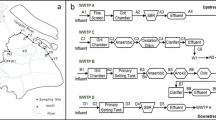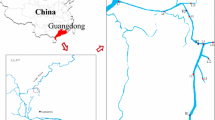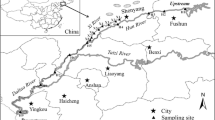Abstract
The occurrence and environmental risk of eight endocrine disrupting compounds (EDCs), namely dimethyl phthalate (DMP), diethyl phthalate (DEP), benzyl butyl phthalate (BBP), dibutyl phthalate (DBP), nonyl phenol (NP), bisphenol A (BPA), 17α-ethinylestradiol (EE2) and estrone (E1), from four water sources (Pingshantou, Wanfenggang, Shisi, and Shiyi) of Huai River (Huainan section) were investigated in this study. Except for DMP only found in Pingshantou, all of the selected EDCs existed widely in the source water. DMP, DEP, BBP, DBP, NP, BPA, EE2, and E1 had the ranges of nd (cannot be detected)-130 ng/L, 25–310, 76–1351, 431–1299, 215–627, 23–107, nd-0.174, and 0.143–0.334 ng/L, respectively. Therefore, the studied water sources were associated with notable levels of EDCs, wherein the concentrations of BBP, DBP, and NP were much higher than the other five chemicals. The selected EDCs appeared to be higher in upstream than in downstream (p < 0.05) for each water source, suggesting that EDCs were subjected to a decreasing with water flow. Correlation analysis suggests that DEP-BP-DBP, NP-BPA, and EE2-E1 might have the same sources, respectively; and the source of NP, EE2, and E1 was different from that of BBP, BEP and BBP, and DEP, respectively. It was observed that both the TAS (total ambient severity) and RQ (risk quotient) were less than 1, indicating that EDCs in Huai River (Huainan section) posed little or no thread to the health of local inhabitants and ecological environmental.




Similar content being viewed by others
References
Barber LB, Loyo-Rosales JE, Rice CP, Minarik TA, Oskouie AK (2015) Endocrine-disrupting alkylphenolic chemicals and other contaminants in wastewater treatment plant effluents, urban streams, and fish in the Great Lakes and Upper Mississippi River Regions. Sci Total Environ 517:195–206
Bayen S, Estrada ES, Juhel G, Kit LW, Kelly BC (2016) Pharmaceutically active compounds and endocrine disrupting chemicals in water, sediments and mollusks in mangrove ecosystems from singapore. Mar Pollut Bull 109(2):716–722
Carvalho AR, Cardoso V, Rodrigues A, Benoliel MJ, Duarte E (2016) Fate and analysis of endocrine-disrupting compounds in a wastewater treatment plant in Portugal. Water Air Soil Pollut 227(6):202
Chen Y (2013) Investigation on pollution of nonylphenol in major water bodies, drinking water and dining utensils in Suzhou and the removal efficiency of some water treatment techniques. Dissertation, Suzhou University (in Chinese)
Chen T, Yun X, Na G, Zhang Y, Yao Z (2009) Determination of estrone, estriol, estradiol in seawater by liquid chromatography-tandem mass spectrometry. Chin J Anal Lab 28(11):41–44 (in Chinese)
Dong J, Wang W, Shang K (2010) Water environment health risk assessment of phthalic acid esters in Lanzhou reach of Yellow River. J Agro Environ Sci 29(5):963–968 (in Chinese)
Fang L (2004) The study on the determination and migration of phthalic acid esters environmental hormones. Dissertation, Beijing University of Technology (in Chinese)
Feng L, Yang G, Zhu L, Xu J, Xu X, Chen Y (2016) Distribution and risk assessment of endocrine-disrupting pesticides in drinking water sources from agricultural watershed. Water Air Soil Pollut 227(1):23
Fung C, Zheng G, Connell D et al (2005) Risks posed by trace organic contaminants in coastal sediments in the Pearl River Delta, China. Mar Pollut Bull 50(10):1036–1049
Gao X, Shi X, Cui Y, Li M, Zhang R, Qian X, Jiang Y (2011) Organic pollutants and ambient severity for the drinking water source of western Taihu Lake. Ecotoxicology 20(5):959–967
Gmurek M, Olak-Kucharczyk M, Ledakowicz S (2017) Photochemical decomposition of endocrine disrupting compounds: a review. Chem Eng J 310:437–456
Guo H, Deng Y, Yao Z et al (2017) A highly selective surface coating for enhanced membrane rejection of endocrine disrupting compounds: mechanistic insights and implications. Water Res 121:197–203
Hou S, Xun J, Wang L, Sun H, Dai S, Liu X (2005) Primary study on nonylphenol and nonylphenol polyethoxylates in aquatic environment at lanzhou reach of yellow river. Environ Chem 24(3):250–254 (in Chinese)
Jin X (2004) Analytical method for endocrine-disrupting chemicals of bisphenol A, 4-tert-oetyiphenol, 4-nonylphenol and their distributions in typical districts in Beijing and Tianjin, China. Dissertation, Nankai University (in Chinese)
Lange C, Kuch B, Metzger JW (2015) Occurrence and fate of synthetic musk fragrances in a small German river. J Hazard Mater 282:34–40
Li Y (2006) Test and degradation of endocrine-disrupting chemicals in drinking water. Dissertation, Tongji University (in Chinese)
Li X, Zou S, Luan T, Weng S, Lin L (2010) Distribution of the three phenolic endocrine disrupting chemicals in the water of Pearl River Estuary, Guangdone. J Saf Environ 10(2):96–101 (in Chinese)
Li Z, Xiang X, Li M, Ma Y, Wang J, Liu X (2015) Occurrence and risk assessment of pharmaceuticals and personal care products and endocrine disrupting chemicals in reclaimed water and receiving groundwater in China. Ecotoxicol Environ Saf 119:74–80
Lin X (2003) Study on phthalic acid esters of environmental hormone in water in Beijing area. Dissertation, Beijing University of Technology (in Chinese)
Liu F, Liu L, Zhang R, Qian X, Li M (2013) Ambient severity evaluation and toxicity effect of organic pollutants in Liuxihe Reservoir, China. J Agro Environ Sci 32(4):756–763 (in Chinese)
Liu D, Wu S, Xu H, Zhang Q, Zhang S, Shi L et al (2017) Distribution and bioaccumulation of endocrine disrupting chemicals in water, sediment and fishes in a shallow Chinese freshwater lake: Implications for ecological and human health risks. Ecotox Environ Safe 140:222–229
Liu F, Liu Y, Jiang D, Zhang R, Cui Y, Li M (2014) Health risk assessment of semi-volatile organic pollutants in Lhasa River China. Ecotoxicology 23(4):567–576
Mirzaei A, Chen Z, Haghighat F, Yerushalmi L (2016) Removal of pharmaceuticals and endocrine disrupting compounds from water by zinc oxide-based photocatalytic degradation: a review. Sustain Cities Soc 27:407–418
Murray A, Örmeci B, Lai EP (2017) Use of sub-micron sized resin particles for removal of endocrine disrupting compounds and pharmaceuticals from water and wastewater. J Environ Sci China 51:256–264
Nie M (2012) Occurrence and phase distribution of selected estrogens in the water of the water source protection area of upper reach of Huangpu River. Dissertation, East China Normal University (in Chinese)
Omar TFT, Ahmad A, Aris AZ, Yusoff FM (2016) Endocrine disrupting compounds (EDCs) in environmental matrices: review of analytical strategies for pharmaceuticals, estrogenic hormones, and alkylphenol compounds. TrAC Trends Anal Chem 85:241–259
Padhye LP, Yao H, Kung’u FT, Huang CH (2014) Year-long evaluation on the occurrence and fate of pharmaceuticals, personal care products, and endocrine disrupting chemicals in an urban drinking water treatment plant. Water Res 51:266–276
Pan S, Xie J (1994) Ambient severity evaluation of organic compounds in underground water. Environ Monit China 10(6):35–37 (in Chinese)
Pei Q, Su G (2000) An assessment of healthy severity of surface water source in Shijiazhuang city. Geogr Territ Res 16(1):67–70 (in Chinese)
Peng X, Yu Y, Tang C, Tan J, Huang Q, Wang Z (2008) Occurrence of steroid estrogens, endocrine-disrupting phenols, and acid pharmaceutical residues in urban riverine water of the Pearl River Delta, South China. Sci Total Environ 397(1):158–166
Peng X, Xiong S, Ou W et al (2017) Persistence, temporal and spatial profiles of ultraviolet absorbents and phenolic personal care products in riverine and estuarine sediment of the Pearl River catchment, China. J Hazard Mater 323:139–146
Peterson RK (2006) Comparing ecological risks of pesticides: the utility of a risk quotient ranking approach across refinements of exposure. Pest Manag Sci 62(1):46–56
Plahuta M, Tišler T, Toman MJ, Pintar A (2017) Toxic and endocrine disrupting effects of wastewater treatment plant influents and effluents on a freshwater isopod Asellus aquaticus (Isopoda, Crustacea). Chemosphere 174:342–353
Sackett DK, Pow CL, Rubino MJ et al (2015) Sources of endocrine disrupting compounds in North Carolina waterways: a geographic information systems approach. Environ Toxicol Chem 34(2):437–445
Salgueiro-Gonzalez N, Turnes-Carou I, Besada V, Muniategui-Lorenzo S, Lopez-Mahia P, Prada-Rodriguez D (2015) Occurrence, distribution and bioaccumulation of endocrine disrupting compounds in water, sediment and biota samples from a European river basin. Sci Total Environ 529:121–130
Santoro G, Melvin SD (2017) Salinity and sensitivity to endocrine disrupting chemicals: a comparison of reproductive endpoints in small-bodied fish exposed under different salinities. Chemosphere 183:186–196
Shao X, Ma J (2008) Preliminary investigation on 13 endocrine disrupting chemicals in the Songhua River. Acta Sci Circum 89:1910–1915 (in Chinese)
Shao X, Ma J, Wen G (2008) Investigation of endocrine disrupting chemicals in a drinking water work located in Songhua River Basin. Environ Sci 29(10):2723–2728 (in Chinese)
Shi W, Zhang FX, Hu GJ et al (2012) Thyroid hormone disrupting activities associated with phthalate esters in water sources from Yangtze River Delta. Environ Int 42:117–123
Sun J, Ji X, Zhang R et al (2016) Endocrine disrupting compounds reduction and water quality improvement in reclaimed municipal wastewater: a field-scale study along Jialu River in North China. Chemosphere 157:232–240
Tain H, Shu W, Cao J (2003) Organic pollutants in drinking source water of the Chang River and Jialing River (Chong Reach). Resour Environ Yangtze Basin 12(2):20–25 (in Chinese)
Tijani JO, Fatoba OO, Petrik LF (2013) A review of pharmaceuticals and endocrine-disrupting compounds: sources, effects, removal, and detections. Water Air Soil Pollut 224(11):1770
USEP (United States Environmental Protection Agency) (2004). EPA science inventory. https://cfpub.epa.gov/si/si_public_record_report.cfm?dirEntryId=47217&keyword=MEG&actType=&TIMSType=+&TIMSSubTypeID=&DEID=&epaNumber=&ntisID=&archiveStatus=Both&ombCat=Any&dateBeginCreated=&dateEndCreated=&dateBeginPublishedPresented=&dateEndPublishedPresented=&dateBeginUpdated=&dateEndUpdated=&dateBeginCompleted=&dateEndCompleted=&personID=&role=Any&journalID=&publisherID=&sortBy=revisionDate&count=50&CFID=77067908&CFTOKEN=11711089. Accessed 18 June 2017
Wang X (1995) Separation and analysis of trace phthalic acid esters of environmental samples. Chin J Anal Chem 23(12):1425–1428
Wang L, Lin A, Fan K, Huang C, Zhou H, Hu J, Qang Z (2006) Research on RDCs and NPEOs in water in Beijing. China Water Wastewater 22:284–287 (in Chinese)
Wang Y, Yuan T, Hu Y (2009) Behaviors and environmental risk assessment of estrogenic endocrine disruptors in anaerobic domestic wastewater treatment. Environ Sci 30(6):1716–1720 (in Chinese)
Wang W, Ndungu AW, Wang J (2016) Monitoring of endocrine-disrupting compounds in surface water and sediments of the Three Gorges reservoir region, China. Arch Environ Contam Toxicol 71(4):509–517
Wei S, Lau R, Fung C et al (2006) Trace organic contamination in biota collected from the Pearl River Estuary, China: a preliminary risk assessment. Mar Pollut Bull 52(12):1682–1694
Xu C, Shu WQ, Luo CH (2007) Water environmental health risk assessment of PAHs and PAEs in the three gorges reservoir. Res Environ Sci 20(5):57–60 (in Chinese)
Xu P (2005) Removal performance and mechanism of typical endocrine disrupting chemicals in water. Postdoctoral thesis, Tongji University (in Chinese)
Yan L, Zheng E, Yang X, Cao Q, Ding J, Shi R (2007) Simultaneously determination of bisphenol A and dibutyl phthalate in drinking water by solid-phase extraction and liquid chromatography hyphenated to mass spectrometry. Chinese Journal of Analysis Laboratory 26(6):10–14
Yan R, Cheng W, Pang Y, Liu Y, Pao C (2009) Pollution characteristics of Sunan canal and the solutions. Yangtze River 21:66–70 (in Chinese)
Yang C (2008) Stability tests of oestrone,17β-oestradiol and 17α-ethinyl oestradiol in sewage samples. Chem Res Appl 20(8):965–971 (in Chinese)
Yang J (2013) Distribution and environmental behavior of typical endocrine disrupting chemicals in water environment of Pearl River Delta. Dissertation, University of Chinese Academy of Sciences (in Chinese)
Yang Y, Li C, Li Y, Liang Y (2017) Research on temporal-spatial migration and transformation of typical endocrine disrupting chemicals in the drinking water source area of Chengdu. China Rural Water Hydropower 5:118–123 (in Chinese)
Yi C (2002) The Research of SPE on the environmental endocrine disruptors in sewage. Dissertation, Beijing University of Technology (in Chinese)
Yoon Y, Ryu J, Oh J, Choi BG, Snyder SA (2010) Occurrence of endocrine disrupting compounds, pharmaceuticals, and personal care products in the Han River (Seoul, South Korea). Sci Total Environ 408(3):636–643
Yu Q, Wang H, An K (2008) Determination of estrogens in water by solid phase extraction-high performance liquid chromatography. J Environ Health 25(5):438 (in Chinese)
Zhang X (2001) Reversed phase liquid chromatography for the analysis of phthalic acid esters from sewage. Petrochem Ind Tech 8(4):225–228 (in Chinese)
Zhang F (2011) Bioanalytical and instrumental analysis of thyroid hormone disrupting organics in water source and drinking water in Jiangsu Province. Dissertation, Nanjing University (in Chinese)
Zhang Y (2012) Study on pollution of bisphenol A in major types of water bodies, drinking water and dining utensils in Suzhou and the technique for removing bisphenol A. Dissertation, Suzhou University (in Chinese)
Zhang Z, Feng Y, Gao P, Wang C, Ren N (2011) Occurrence and removal efficiencies of eight EDCs and estrogenicity in a STP. J Environ Monitor 13(5):1366–1373
Acknowledgements
The water plants provided us with the basic information of studied water sources and issued the permission to conduct the sampling in water sources. The authors are grateful for the support.
Author information
Authors and Affiliations
Corresponding author
Rights and permissions
About this article
Cite this article
Niu, S., Zhang, C. Endocrine Disrupting Compounds from the Source Water of the Huai River (Huainan City), China. Arch Environ Contam Toxicol 74, 471–483 (2018). https://doi.org/10.1007/s00244-017-0445-2
Received:
Accepted:
Published:
Issue Date:
DOI: https://doi.org/10.1007/s00244-017-0445-2




